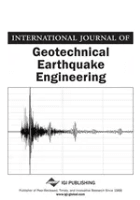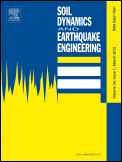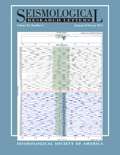
EARTHQUAKE SPECTRA
metrics 2024
Elevating geophysical knowledge for resilient infrastructure.
Introduction
EARTHQUAKE SPECTRA, published by SAGE PUBLICATIONS INC, is a premier journal dedicated to the field of geophysics, geotechnical engineering, and engineering geology, with a specific focus on seismic phenomena. Issued both in print (ISSN: 8755-2930) and electronically (E-ISSN: 1944-8201), the journal has maintained its position as a leading source of high-quality research since its inception in 1984. Recognized in the 2023 Category Quartiles as Q1 in both geophysics and geotechnical engineering, it is highly regarded in the academic community, ranking 11 out of 165 in its field, placing it in the 93rd percentile of Earth and Planetary Sciences, and 30 out of 229 for geotechnical engineering with an 87th percentile standing. With a commitment to advancing knowledge and practice in earthquake engineering, EARTHQUAKE SPECTRA publishes original research, case studies, and critical reviews that inform the design and construction practices related to seismic events. Although it does not currently offer open access, the journal's impact on the discipline remains significant, making it an essential resource for researchers, professionals, and students dedicated to understanding and mitigating the effects of earthquakes.
Metrics 2024
 1.25
1.25 3.10
3.10 3.70
3.70 113
113Metrics History
Rank 2024
Scopus
IF (Web Of Science)
JCI (Web Of Science)
Quartile History
Similar Journals

STRUCTURAL ENGINEERING AND MECHANICS
Unveiling Insights into Structural Systems and MechanicsSTRUCTURAL ENGINEERING AND MECHANICS, a leading journal published by TECHNO-PRESS, stands at the forefront of research in the disciplines of civil, structural, and mechanical engineering. With an ISSN of 1225-4568 and an E-ISSN of 1598-6217, this South Korea-based journal has been a significant contributor to the academic community since its inception in 1994, and it continues to disseminate vital research through 2024 and beyond. Achieving a Q3 ranking in key categories such as Building and Construction, Civil and Structural Engineering, Mechanical Engineering, and Mechanics of Materials, the journal is recognized for its high standard of academic rigour and relevance in contemporary engineering challenges. Although not Open Access, it offers robust access options for institutions and professionals seeking to advance their understanding of structural systems and mechanics. Researchers, students, and practitioners in these fields will find invaluable insights and innovative studies that push the boundaries of knowledge, making this journal an essential resource for anyone invested in engineering advancements.

JOURNAL OF SEISMOLOGY
Advancing seismic understanding through rigorous research.Welcome to the JOURNAL OF SEISMOLOGY, an esteemed publication in the field of Earth sciences, dedicated to the study of seismic phenomena and their implications on geophysical and geochemical processes. Published by SPRINGER and based in the Netherlands, this journal has been contributing to the academic community since 1997 and is set to continue through 2024. With an impressive ranking within the quartiles—Q2 in Geophysics and Q3 in Geochemistry and Petrology for 2023—this journal is a pivotal resource for researchers and professionals seeking to expand their understanding of seismic activities, earthquake mechanics, and related geological interactions. Despite not offering open access, it remains a highly regarded platform for disseminating rigorous research and findings in Earth and Planetary Sciences, sustaining a global readership keen on advancing their knowledge in this dynamic field. The JOURNAL OF SEISMOLOGY is committed to fostering scholarly exchange and advancing scientific inquiry, making it an invaluable asset for students, researchers, and professionals alike.

Ingegneria Sismica
Transforming understanding of seismic risk mitigation strategies.Ingegneria Sismica, a premier journal published by PATRON EDITORE S R L, serves as an essential platform for the dissemination of research in the fields of building and construction, geotechnical engineering, and safety risk management. With a focus on earthquake engineering and structural safety, the journal has established itself as a prominent source of knowledge since its inception in 2010. The journal holds an impressive Q2 classification in multiple categories, including Building and Construction and Geotechnical Engineering, reflecting its significant impact within these disciplines. Despite its Italian roots, it appeals to an international audience of researchers, professionals, and students dedicated to advancing the understanding of seismic resilience and risk mitigation strategies. Although open access is not currently available, the potential for knowledge sharing and innovative methodologies presented in the articles continues to attract a robust readership. With its commitment to excellence and relevance, Ingegneria Sismica is poised to shape future discourse in engineering practices aimed at enhancing safety, reliability, and quality within seismic zones.

International Journal of Geotechnical Earthquake Engineering
Exploring the dynamics of soil and structure in earthquake engineering.International Journal of Geotechnical Earthquake Engineering, published by IGI Global, serves as a pivotal platform for researchers and practitioners in the field of geotechnical engineering and engineering geology. Established in 2010, this journal has steadily promoted the dissemination of innovative research and advancements in understanding the impact of seismic activities on soil behavior and structural integrity. Operating out of the United States, it caters to a global audience and offers a range of articles that delve deep into the dynamics of earthquake engineering. With a 2023 Scopus ranking placing it in the 39th percentile among its peers and a Q4 designation in the relevant quartile, the journal actively seeks to elevate the discussion around geotechnical challenges associated with seismic events. While currently not classified as an Open Access journal, it remains committed to providing valuable insights that aid in the prevention and mitigation of geotechnical failures during earthquakes. Researchers, professionals, and students alike will find this journal an essential resource for the latest developments and practical applications in this ever-evolving field.

SOIL DYNAMICS AND EARTHQUAKE ENGINEERING
Bridging Disciplines for a Safer, More Resilient FutureSOIL DYNAMICS AND EARTHQUAKE ENGINEERING is a premier academic journal published by ELSEVIER SCI LTD, focusing on the intersection of civil and structural engineering, geotechnical engineering, and soil science. Since its inception in 1986, the journal has established itself as a critical resource for advancing knowledge in these fields over nearly four decades, with a remarkable Q1 ranking in 2023 across multiple categories, including Civil and Structural Engineering, Geotechnical Engineering, and Soil Science. The journal’s impactful research, reflected in its high Scopus ranks, serves as a vital reference for both professionals and academics dedicated to understanding soil dynamics and mitigating earthquake hazards. Although it currently does not offer open access, the journal's rigorous peer-review process ensures that published articles provide substantial contributions to the understanding of soil behavior under seismic conditions. Whether you are a researcher, a practitioner, or a student, SOIL DYNAMICS AND EARTHQUAKE ENGINEERING offers essential insights and innovative methodologies pivotal for advancing your work in soil dynamics and earthquake engineering.

JOURNAL OF ENGINEERING MECHANICS
Unleashing Potential Through Cutting-Edge MechanicsJOURNAL OF ENGINEERING MECHANICS, published by the ASCE - American Society of Civil Engineers, stands as a premier interdisciplinary journal in the field of engineering mechanics. With an impact factor reflecting its vital contributions—placing it in the Q1 category for both Mechanical Engineering and Mechanics of Materials—this journal has established itself as a critical resource for researchers and professionals alike. Since its inception in 1981 and continuing through 2024, it has provided a platform for the dissemination of high-quality research, emphasizing innovative methodologies and cutting-edge findings. The journal's ranking in Scopus further underscores its significance, with impressive standings in the 79th and 77th percentiles of its respective categories. As a vital resource for students and professionals aiming to stay abreast of developments in engineering mechanics, it remains committed to fostering rigorous scientific exploration and practical applications within the field.

Turkish Journal of Civil Engineering
Fostering Collaboration for a Sustainable FutureWelcome to the Turkish Journal of Civil Engineering, a pioneering publication under the auspices of the TURKISH CHAMBER OF CIVIL ENGINEERS, dedicated to advancing the field of civil engineering and construction. With a focus on cutting-edge research and innovative practices, this journal seeks to provide a platform for scholars, professionals, and students to share their findings and insights within the sphere of civil and structural engineering. The journal is committed to open access, ensuring that research is readily available to a global audience. As it embarks on its journey from 2023 to 2024, it aims to enhance its reputation as a vital resource within the academic community, currently ranking in the 40th percentile for Building and Construction Engineering and 32nd for Civil and Structural Engineering in Scopus. We encourage contributions that push the boundaries of engineering knowledge, fostering collaboration and progress in this essential field.

SEISMOLOGICAL RESEARCH LETTERS
Exploring the depths of seismic phenomena with precision.SEISMOLOGICAL RESEARCH LETTERS is a leading journal in the field of geophysics, published by the Seismological Society of America. With its ISSN 0895-0695 and E-ISSN 1938-2057, this prestigious publication serves as a vital platform for disseminating groundbreaking research and advancements in seismological science. The journal boasts an impressive Q1 categorization in the 2023 rankings and ranks 23rd out of 165 in Earth and Planetary Sciences, Geophysics, placing it within the 86th percentile among its peers. Spanning an illustrious history from its origination in 1984 to its ongoing contributions through 2024, it is dedicated to fostering a deeper understanding of seismic phenomena. Although it currently does not offer open access, researchers, professionals, and students can benefit from timely insights and comprehensive studies presented in its pages. Set within the heart of the United States, the journal stands as a cornerstone in geophysics, connecting a global community eager to advance their knowledge and impact in the field.

Italian Geotechnical Journal-Rivista Italiana di Geotecnica
Bridging Theory and Application in Geotechnical Engineering.Italian Geotechnical Journal-Rivista Italiana di Geotecnica, published by PATRON EDITORE S R L, is a rigorously peer-reviewed journal dedicated to advancing the field of geotechnical engineering and engineering geology. With a history dating back to 1976 and an active publication span from 2011 to 2024, the journal provides a vital platform for researchers and practitioners to disseminate innovative findings and methodologies in the field. Although it currently holds a Q4 category ranking in Geotechnical Engineering and Engineering Geology, the journal is committed to maintaining high academic standards and quality of publication. Its Scopus ranking places it within the 29th percentile of Earth and Planetary Sciences, indicating its significance among scholarly publications. The Italian Geotechnical Journal serves not only as a resource for academic inquiry but also as an essential tool for professionals seeking to stay abreast of the latest developments and applications in geotechnical research. This journal is essential for students and researchers aiming to deepen their knowledge and contribute to ongoing discourse in geotechnics.

Underground Space
Pioneering Research in Geotechnical ScienceUnderground Space is a distinguished academic journal dedicated to the multidisciplinary field of underground engineering and geotechnical science. Published by KEAI PUBLISHING LTD, this open-access journal has been contributing to the knowledge base since 2016, ensuring that research findings are accessible to a global audience. With an impressive Q1 ranking in categories such as Building and Construction, Civil and Structural Engineering, and Geotechnical Engineering, it reflects the journal's high impact and relevance within the academic community. The journal's Scopus rankings further signify its reputation, standing 16th in both Earth and Planetary Sciences and Engineering, and reaching the 93rd percentile in Geotechnical Engineering and Engineering Geology. Researchers, professionals, and students alike rely on Underground Space as a key resource for exploring the complexities of underground environments and infrastructure development. With its goal to advance knowledge in underground construction and sustainability practices, this journal is essential for anyone engaged in related research and practice.